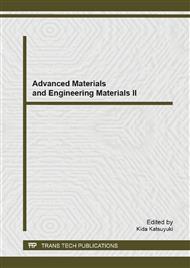[1]
Victor C. Li. On Engineered cementitious composites: a review of the material and its applications[J]. Adv Concrete Technol, 2003, 1(3): 215–30.
Google Scholar
[2]
Bentur A, Mindess S. Fiber reinforced cementitious composites[M]. Amsterdam: Elsevier Science Publishers, (1990).
Google Scholar
[3]
Kanda T. Design of engineered cementitious composites for ductile seismic resistant elements, in department of civil and environmental engineering[D]. Ann Arbor: University of Michigan, (1998).
Google Scholar
[4]
Y.Y. Kim, H. -J. Kong, Victor C. Li, Design of engineered cementitious composite suitable for wet-mixture shotcreting[J]. ACI Materials, 2003, 100 (6): 511 –18.
DOI: 10.14359/12958
Google Scholar
[5]
Akkaya Y, Shah SP, Ankenman B. Effect of fiber dispersion on multiple cracking of cement composites[J]. Eng Mater Civil Eng 2001, 127(4): 311–316.
DOI: 10.1061/(asce)0733-9399(2001)127:4(311)
Google Scholar
[6]
Ozyurt N. Correlating fiber dispersion, rheology and mechanical performance for fiber-reinforced cement-based materials[D]. Istanbul, Istanbul Technical University, (2006).
Google Scholar
[7]
Torigoe S, Horikoshi T, Ogawa A. Study on evaluation method for PVA fiber distribution in engineered cementitious composite[J]. Adv Concr Technol, 2003, 1(3): 265–8.
DOI: 10.3151/jact.1.265
Google Scholar
[8]
Yang Y. Methods study on dispersion of fibers in CFRC[J]. Cem Concr Res, 2002, 32: 747–50.
Google Scholar
[9]
Benson SDP, Karihaloo BL. CARDIFRC—manufacture and constitutive behavior. In: High performance fiber reinforced cement composites (HPFRCC4), Ann Arbor. Mich, 2003: 65–79.
Google Scholar
[10]
Ozyurt N, Woo LY, et al. Monitoring fiber dispersion in fiber-reinforced cementitious materials: comparison of AC-impedance spectroscopy and image analysis [J]. ACI Mater, 2006, 103(5): 340–7.
DOI: 10.14359/18156
Google Scholar
[11]
Ozyurt N, Mason TO, Shah SP. Correlation of fiber dispersion, rheology and mechanical performance of FRCs[J]. Cem Concr Compos, 2007, 29(2): 70–9.
DOI: 10.1016/j.cemconcomp.2006.08.006
Google Scholar
[12]
Bang Yeon Lee, et al. Quantitative evaluation technique of Polyvinyl Alcohol (PVA) fiber dispersion in engineered cementitious composites[J]. Cem Concr Compos, 2009, 31: 408-17.
DOI: 10.1016/j.cemconcomp.2009.04.002
Google Scholar
[13]
Jian Zhou, Shunzhi Qian, et al. Improved fiber distribution and mechanical properties of engineered cementitious composites by adjusting the mixing sequence. Cement Concrete Comp (2011), doi: 10. 1016/j. cemconcomp. 2011. 11. 019.
DOI: 10.1016/j.cemconcomp.2011.11.019
Google Scholar
[14]
Wang S. Micromechanics based matrix design for engineered cementitious composites, in departmental of civil and environmental engineering[D]. Ann Arbor: University of Michigan; (2005).
Google Scholar
[15]
M. Nehdi, S. Mindess, et al. Rheology of high- performance concrete: effect of ultra-fine particles[J]. Cem Concr Res, 1998, 28 (5): 687 –97.
DOI: 10.1016/s0008-8846(98)00022-2
Google Scholar
[16]
C.F. Ferraris, K.H. Obla, R. Hill. The influence of mineral admixtures on the rheology of cement paste and concrete[J]. Cem Concr Res, 2001, 31 (2): 245 –55.
DOI: 10.1016/s0008-8846(00)00454-3
Google Scholar
[17]
Wang S, Victor C. Li. Engineered Cementitious Composites with High-Volume Fly Ash[J]. ACI Materials, 2007, 5(3): 233-41.
Google Scholar
[18]
Hyun-Joon Kong, et al. Development of a self-consolidating engineered cementitious composite employing electrosteric dispersion/stabilizatio[J]. Cem Concr Compos, 2003, 25: 301-9.
DOI: 10.1016/s0958-9465(02)00057-4
Google Scholar
[19]
Kim J K, Kim J S, Gee J H, et al. Tensile and Fiber Dispersion Performance of ECC Produced with Ground Granulated Blast Furnace Slag [J]. Cem Concr Res, 2007, (37): 1096-1105.
DOI: 10.1016/j.cemconres.2007.04.006
Google Scholar
[20]
Yang EH, Sahmaran M, Yang Y, Victor C. Li. Rheological control in the production of engineered cementitious composites[J]. ACI Mater, 2009, 106(4): 357–66.
Google Scholar
[21]
Chong Wang, Changhui Yang, et al. Preparation of Ultra-High Performance Concrete with common technology and materials[J]. Cem Concr Compos, 2012, 34: 538-44.
Google Scholar
[22]
WU C. Micromechanical tailoring of PVA-FRCC for structural applications in departmental of civil and environmental engineering[D]. Ann Arbor: University of Michigan, (2001).
Google Scholar
[23]
Weimann MB, Victor C. Li. Hygral behavior of engineered cementitious composite (ECC) [J]. Restoration Build Monument, 2003, 9(5): 513–34.
Google Scholar
[24]
N. Feng, Y. Shi, T. Hao. Influence of ultra-fine powder on the fluidity and strength of cement paste[J]. Advances in Cement Research, 2000, 12 (3): 89–95.
DOI: 10.1680/adcr.2000.12.3.89
Google Scholar
[25]
J. Hill, J.H. Sharp. The mineralogy and microstructure of three composite cements with high replacement levels[J]. Cem Concr Compos, 2002, 24 (2): 191–99.
DOI: 10.1016/s0958-9465(01)00041-5
Google Scholar
[26]
Y. Shi, et al. A study on the effect of fine mineral powders with distinct vitreous contents on the fluidity and rheological properties of concrete[J]. Cem Concr Res, 2004, 34 (8): 1381 –87.
DOI: 10.1016/j.cemconres.2003.12.031
Google Scholar
[27]
M Ahmaran, et al. Influence of Aggregate Type and Size on Ductility and Mechanical Properties of Engineered Cementitious Composites[J]. ACI Mater, 2009, 106(3): 308-16.
DOI: 10.14359/56556
Google Scholar
[28]
Jun Zhang, Bing Leng. Transition from Multiple Macro-Cracking to Multiple Micro-Cracking in Cementitious Composites[J]. TSINGHUA SCIENCE AND TECHNOLOGY, 2008, 13(5): 669–73.
DOI: 10.1016/s1007-0214(08)70109-3
Google Scholar


